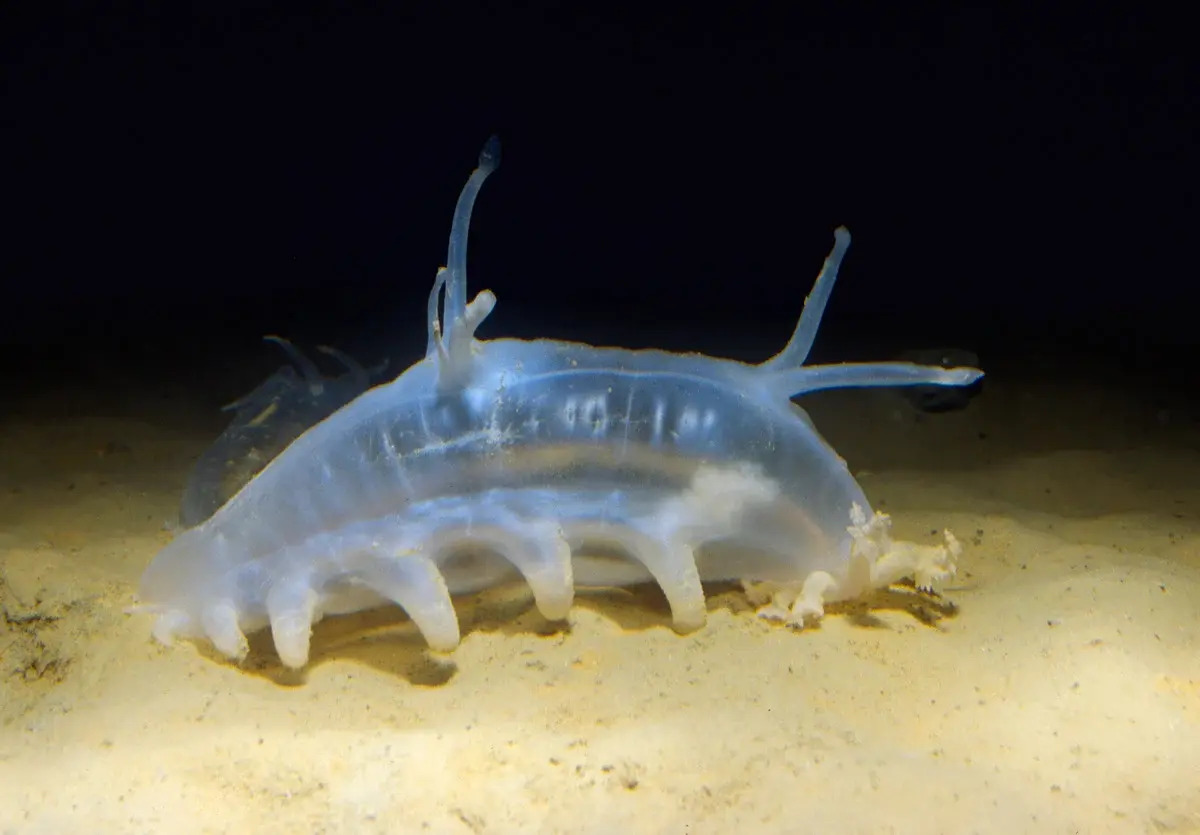
Sea pigs, scientifically known as Scotoplanes, are mysterious deep-sea dwellers that captivate scientists and ocean enthusiasts alike. Found at depths ranging from 1,000 meters to 16,000 feet, these creatures play a crucial role in the ocean ecosystem. With their unique appearance—elongated bodies and numerous tube-like appendages—they resemble pigs, hence their name. Sea pigs are scavengers, feeding on carrion and detritus, and they possess some truly bizarre traits, like breathing through their anus. Despite their importance, they remain largely unknown to the public. Let's dive into 35 intriguing facts about these enigmatic creatures and uncover their secrets.
Key Takeaways:
- Sea pigs, also known as Scotoplanes, are deep-sea scavengers with tube-like legs and antennae. They play a crucial role in maintaining the health of the deep-sea ecosystem by aerating the substrate while searching for food.
- Sea pigs have a unique appearance and fascinating behaviors, such as breathing through their anus. Despite their toxic skin and parasitic infections, they are not currently listed as an endangered species, but their conservation status is still Data Deficient.
What Are Sea Pigs?
Sea pigs, also known as Scotoplanes, are deep-sea dwellers that intrigue scientists and ocean enthusiasts alike. These creatures, often mistaken for sea cucumbers, have unique characteristics that set them apart.
-
Scientific Name
The scientific name for sea pigs is Scotoplanes. This genus includes several species of deep-sea cucumbers commonly referred to as sea pigs. -
Appearance
Sea pigs resemble pigs due to their elongated bodies and numerous tube-like appendages. They typically range in length from 6 inches to 15 cm and weigh up to 95 ounces. -
Habitat
These creatures dwell on the ocean floor at depths ranging from 1,000 meters to as much as 16,000 feet. Their habitat is characterized by deep-sea mud and organic material, which they feed on.
Feeding and Locomotion
Understanding how sea pigs feed and move provides insight into their survival in the deep sea.
-
Feeding Behavior
Sea pigs are scavengers that primarily feed on carrion and detritus. They use their tube-like legs to push food into their mouths and their antennae-like appendages to detect food particles. -
Locomotion
Unlike other sea cucumbers, sea pigs do not swim. Instead, they hover above the muddy substrate and walk along the ocean floor using their tube-like legs. -
Antennae
The two antennae-like structures on the head of a sea pig are actually legs. These appendages are used to detect food particles in the deep-sea environment.
Discovery and Distribution
Sea pigs have a rich history of discovery and are widely distributed across the globe.
-
Discovery
The first description of sea pigs was made by Swedish zoologist Hjalmar Théel in 1882. Since then, these creatures have garnered significant attention for their unique characteristics and ecological importance. -
Distribution
Sea pigs are found in all the world's oceans. In some areas, they comprise more than 95% of the total weight of animals on the deep-sea floor, highlighting their abundance in these environments.
Behavioral Patterns and Ecological Role
Sea pigs exhibit fascinating behaviors and play a crucial role in their ecosystem.
-
Behavioral Patterns
Large groups of sea pigs can sometimes be seen all facing the same direction. They face into the ocean’s current to detect the faint smell of fallen carcasses, which is crucial for their feeding behavior. -
Ecological Role
In addition to feeding on carrion and detritus, sea pigs play a significant role in maintaining the health of the deep-sea ecosystem. By stirring up the substrate while searching for food, they inadvertently aerate it, making it livable for other creatures.
Defense Mechanisms and Breathing
Sea pigs have unique ways of defending themselves and breathing in their harsh environment.
-
Toxins in Skin
The skin of sea pigs contains holothurins, which are powerful toxins that can cause painful dermatitis, irritation of mucous membranes, potential blindness, and even death if consumed. These toxins serve as a defense mechanism against predators. -
Breathing Mechanism
One of the most unusual features of sea pigs is their ability to breathe through their anus. This unique respiratory system allows them to extract oxygen from the water.
Parasites and Predator Avoidance
Sea pigs have developed interesting relationships with other marine creatures, both as hosts and protectors.
-
Parasites
Sea pigs host a variety of parasites, including crustaceans and snails. These parasites bore into the flesh of the sea pig and feast on them from the inside, a process known as endoparasitism. -
Predator Avoidance
Baby king crabs have been observed clinging to sea pigs and other sea cucumbers. It is believed that this behavior may be for protection, as sea pigs are poisonous and can deter predators.
Media Appearances and Public Awareness
Sea pigs have captured the public's imagination through various media and social platforms.
-
Media Appearances
Sea pigs gained significant media attention with their appearance in David Attenborough’s “Blue Planet II” episode 2. The episode showcased these creatures in their natural habitat, providing a glimpse into their fascinating world. -
Public Awareness
The first public awareness about sea pigs came via a Facebook post in 2013. The post described these creatures as marine animals that live about 1,000 meters down on the deep-sea floor and feed on deep ocean mud. -
Video Footage
Humorous video footage about sea pigs and other sea cucumbers can be found on YouTube channels like zefrank1. The video, titled “True Facts About The Sea Pig,” provides an entertaining and educational look at these creatures.
Conservation Status and Lifespan
Despite their ecological importance, sea pigs face challenges in terms of conservation and longevity.
-
Endangered Status
Despite their ecological importance, sea pigs are not currently listed as an endangered species by the IUCN. However, they are still classified as Data Deficient due to the lack of comprehensive data on their populations and habitats. -
Lifespan
The lifespan of a sea pig can range up to 78 years or more. This long lifespan is remarkable considering the harsh conditions they live in.
Weight and Feeding Habits
Sea pigs have unique feeding habits that contribute to their weight and overall health.
-
Weight Variability
Sea pigs can weigh up to 95 ounces, which is significant given their small size. This weight variability is due to their ability to accumulate organic material from their diet. -
Feeding on Carrion
Sea pigs are scavengers that prefer to feast on carrion (dead animals). This feeding behavior is crucial for maintaining the balance of nutrients in the deep-sea ecosystem. -
Feeding on Detritus
In addition to carrion, sea pigs also feed on detritus, which includes decaying plant and animal matter. This diet helps in recycling nutrients in the deep-sea environment.
Unique Appearance and Study Challenges
The distinct look of sea pigs and the difficulties in studying them make these creatures even more intriguing.
-
Unique Appearance
The elongated body of a sea pig, combined with its numerous tube-like appendages, gives it a unique appearance that is often described as resembling a pig. This appearance is what led to their common name. -
Difficulty in Study
Due to their deep-sea habitat, studying sea pigs is challenging. The extreme depths at which they live make it difficult for scientists to collect data and observe these creatures in their natural environment.
Role in Ecosystem and Toxic Skin
Sea pigs are vital to their ecosystem and possess unique defense mechanisms.
-
Role in Ecosystem
Sea pigs play a crucial role in maintaining the health of the deep-sea ecosystem. By stirring up the substrate while searching for food, they inadvertently aerate it, making it livable for other creatures. -
Toxic Skin
The skin of sea pigs contains powerful toxins called holothurins. These toxins serve as a defense mechanism against predators and can cause painful dermatitis if touched.
Breathing Through Anus and Parasitic Infections
Sea pigs have some of the most unusual biological features and relationships with parasites.
-
Breathing Through Anus
One of the most unusual features of sea pigs is their ability to breathe through their anus. This unique respiratory system allows them to extract oxygen from the water. -
Parasitic Infections
Sea pigs host a variety of parasites, including crustaceans and snails. These parasites bore into the flesh of the sea pig and feast on them from the inside, a process known as endoparasitism.
Predator Avoidance and Media Representation
Sea pigs have developed fascinating ways to avoid predators and have been featured in various media outlets.
-
Predator Avoidance Mechanism
Baby king crabs have been observed clinging to sea pigs and other sea cucumbers. It is believed that this behavior may be for protection, as sea pigs are poisonous and can deter predators. -
Media Representation
Sea pigs have been featured in various media outlets, including documentaries like David Attenborough’s “Blue Planet II” and educational videos on YouTube channels like Critter Science.
Public Interest and Ecological Importance
Growing public interest and the ecological significance of sea pigs highlight their importance in the marine world.
-
Public Interest
The public interest in sea pigs has been growing over the years, with more people becoming aware of these fascinating creatures through social media and educational content. -
Ecological Importance
Despite their small size, sea pigs play a significant role in maintaining the balance of nutrients in the deep-sea ecosystem. Their feeding behavior and unique respiratory system contribute to their ecological importance.
Conservation Status and Lifespan Variability
The conservation status and lifespan of sea pigs are crucial aspects of their existence.
-
Conservation Status
Sea pigs are not currently listed as an endangered species by the IUCN. However, they are still classified as Data Deficient due to the lack of comprehensive data on their populations and habitats. -
Lifespan Variability
The lifespan of a sea pig can range up to 78 years or more. This long lifespan is remarkable considering the harsh conditions they live in.
Unique Respiratory System
The unique way sea pigs breathe sets them apart from many other marine creatures.
- Unique Respiratory System
The ability of sea pigs to breathe through their anus is one of the most unusual features of these creatures. This unique respiratory system allows them to extract oxygen from the water, which is essential for their survival in the deep-sea environment.
The Fascinating World of Sea Pigs
Sea pigs, or Scotoplanes, are truly remarkable creatures of the deep sea. Their unique appearance, with elongated bodies and tube-like appendages, sets them apart. Living at depths of up to 16,000 feet, they play a crucial role in the ocean ecosystem by scavenging on carrion and detritus, thus recycling nutrients. Their ability to breathe through their anus and the presence of toxins in their skin are just a few of their fascinating adaptations. Despite their importance, sea pigs remain largely unknown to the public. By understanding these 35 facts, we gain a deeper appreciation for their ecological significance. Whether it's their role in aerating the ocean floor or their intriguing feeding behaviors, sea pigs are essential to the health of our oceans. Let's continue to explore and protect these incredible creatures.
Frequently Asked Questions
Was this page helpful?
Our commitment to delivering trustworthy and engaging content is at the heart of what we do. Each fact on our site is contributed by real users like you, bringing a wealth of diverse insights and information. To ensure the highest standards of accuracy and reliability, our dedicated editors meticulously review each submission. This process guarantees that the facts we share are not only fascinating but also credible. Trust in our commitment to quality and authenticity as you explore and learn with us.


